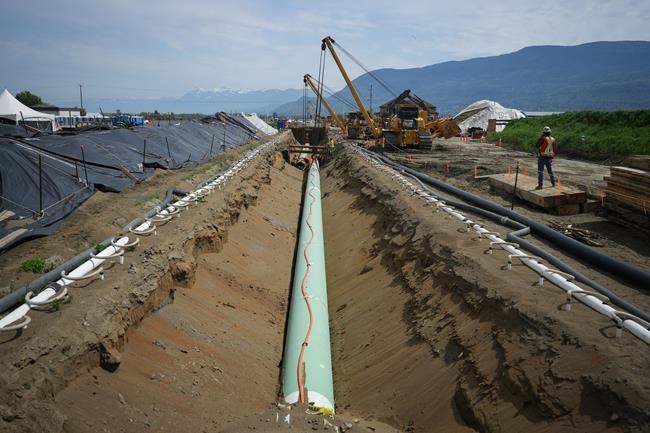CALGARY — After more than four years of construction and at least $34 billion in costs, the Trans Mountain pipeline expansion project is nearly complete. Here's a look at what milestones to expect in the coming weeks as the massive pipeline gets ready to start shipping Canadian oil to the West Coast:
Resolution of B.C. construction challenges: Crown corporation Trans Mountain Corp. has been dealing with construction-related challenges in the Fraser Valley between Hope and Chilliwack, where it encountered an "obstruction" when trying to pull the pipe into the horizontal hole that had been drilled for it. The setback forced the company to remove the pipe temporarily to address the issue, but Trans Mountain Corp. says it is nearing a resolution and expects to be able to re-install the pipe in that section within the next couple of weeks.
Mechanical completion: This marks the final stage of physical construction of the pipeline. Once the challenging segment of pipe has been successfully pulled back into its location, Trans Mountain will be able to complete the "final weld," or what is formally known as mechanical completion.
Leave To Open: After construction is finished but before the pipeline can be put into service, there are several regulatory steps that must be completed. In accordance with the Canada Energy Regulator Act, companies require permission from the CER before commencing operations of a pipeline. This process is called Leave to Open and requires results from a series of inspections and safety tests. Because the Trans Mountain project has been constructed in phases, the company has been applying for Leave to Open permission in stages in order to allow flexibility during the commissioning and startup process.
Line fill: This term is used to describe the final stages of work required to prepare and ultimately fill the expanded pipeline system with more than four million barrels of oil. The process will take several weeks to complete. While line fill has not yet started on the newly constructed pipe, part of the Trans Mountain expansion project involves reactivating two older pipeline segments that had been maintained in a deactivated state. Initial line fill has already begun in B.C. on that section of the project.
In-service: This term refers to when the entire expanded pipeline system is fully operational and ready to make regular deliveries. According to a Bloomberg report, China's Sinochem Group has purchased one of the first shipments, a 550,000-barrel cargo from Suncor Energy Inc., which will load from the Trans Mountain expansion pipeline in May-June. Trans Mountain is continuing to target an in-service date sometime in the second quarter of 2024.
Cleanup and reclamation: Once the expanded pipeline is operational, required cleanup and reclamation work will continue in the project's construction zone.
This report by The Canadian Press was first published March 26, 2024.
The Canadian Press
Note to readers: This is a corrected story. In a previous version, The Canadian Press erroneously reported the expanded pipeline system would eventually be filled with more than four billion barrels of oil. In fact, the pipeline will be filled with more than four million barrels of oil.



